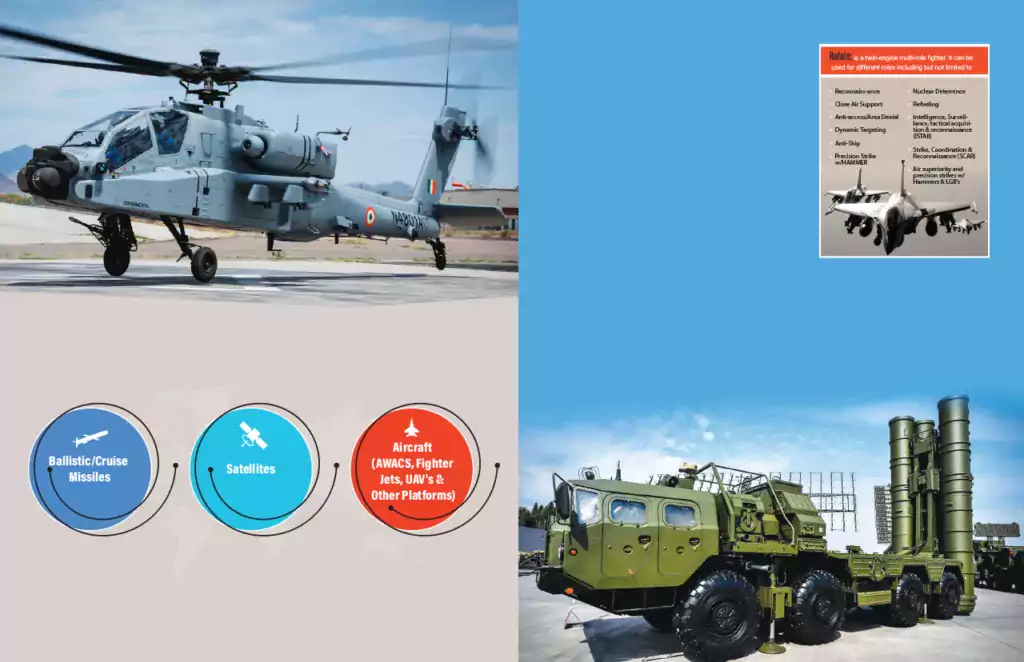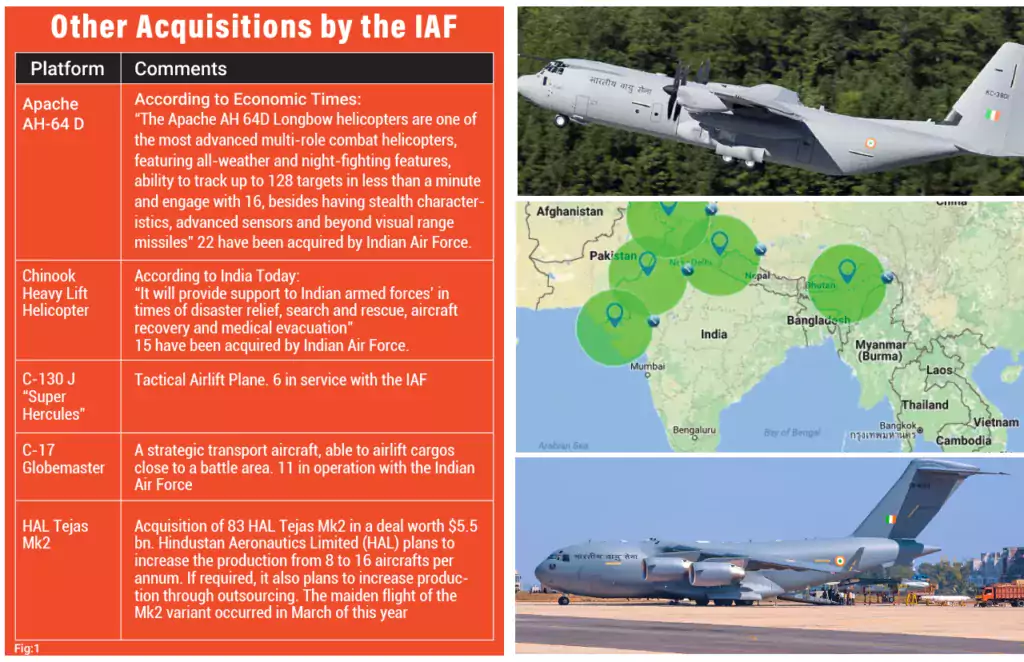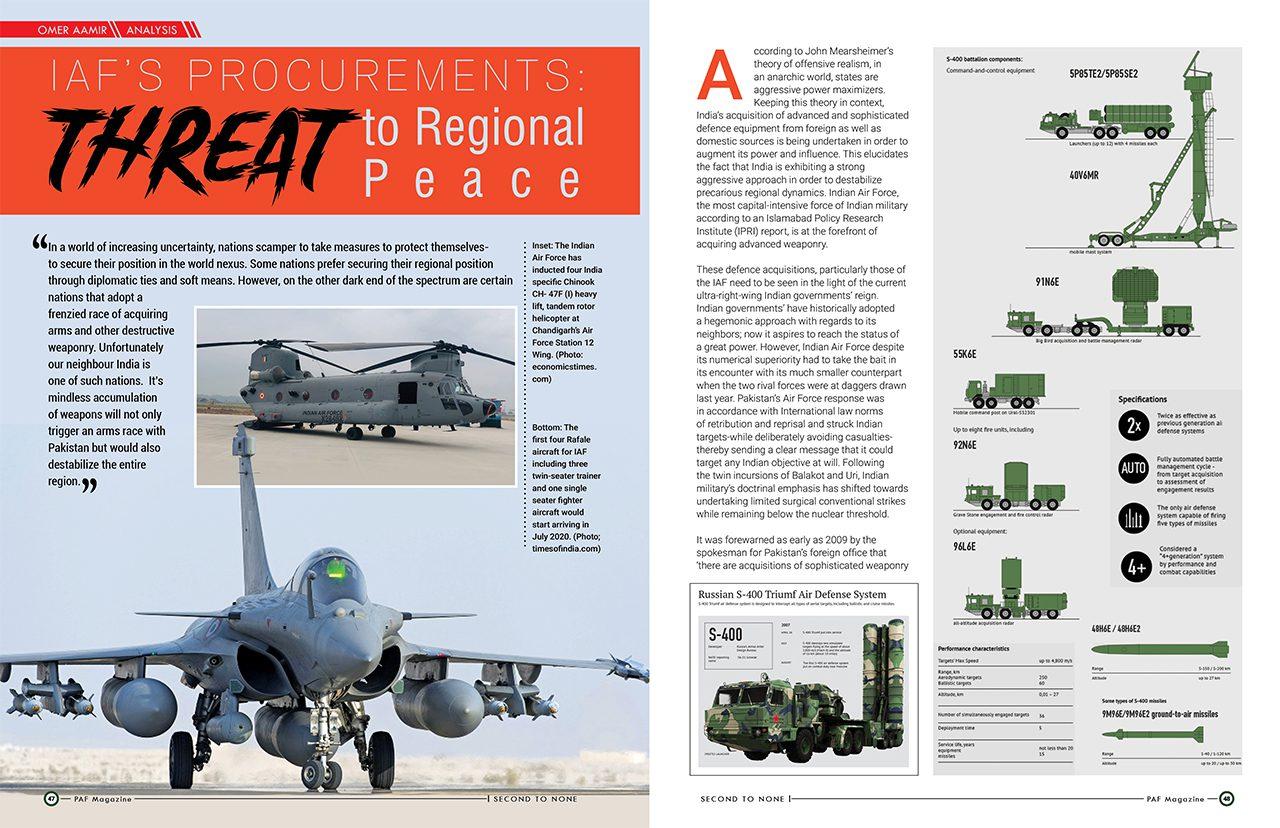In a world of increasing uncertainty, nations scamper to take measures to protect themselves-to secure their position in the world nexus. Some nations prefer securing their regional position through diplomatic ties and soft means. However, on the other dark end of the spectrum are certain nations that adopt a frenzied race of acquiring arms and other destructive weaponry. Unfortunately our neighbour India is one of such nations. It’s mindless accumulation of weapons will not only trigger an arms race with Pakistan but would also destabilize the entire region.
According to John Mearsheimer’s theory of offensive realism, in an anarchic world, states are aggressive power maximizers. Keeping this theory in context, India’s acquisition of advanced and sophisticated defence equipment from foreign as well as domestic sources is being undertaken in order to augment its power and influence. This elucidates the fact that India is exhibiting a strong aggressive approach in order to destabilize precarious regional dynamics. Indian Air Force, the most capital-intensive force of Indian military according to an Islamabad Policy Research Institute (IPRI) report, is at the forefront of acquiring advanced weaponry.
These defence acquisitions, particularly those of the IAF need to be seen in the light of the current ultra-right-wing Indian governments’ reign. Indian governments’ have historically adopted a hegemonic approach with regards to its neighbors; now it aspires to reach the status of a great power. However, Indian Air Force despite its numerical superiority had to take the bait in its encounter with its much smaller counterpart when the two rival forces were at daggers drawn last year. Pakistan’s Air Force response was in accordance with International law norms of retribution and reprisal and struck Indian targets-while deliberately avoiding casualties-thereby sending a clear message that it could target any Indian objective at will. Following the twin incursions of Balakot and Uri, Indian military’s doctrinal emphasis has shifted towards undertaking limited surgical conventional strikes while remaining below the nuclear threshold.
It was forewarned as early as 2009 by the spokesman for Pakistan’s foreign office that ‘there are acquisitions of sophisticated weaponry by our neighbor which will disturb the conventional balance between our two countries and hence, lower the nuclear threshold’. Ever since the Modi government has taken over, the acquisition of these weaponry has picked up pace especially after the escalation of 2019. In a bid to further acquire the latest technology available in the international market, IAF’s chief stated at the beginning of March that acquisition of 36 Rafale jets will be insufficient for the country’s defence.

The acquisition of ‘sophisticated weaponry’ by India tends to fall under the larger concept of force employment. Concept of force employment in developing a war winning strategy is critical in context of future South Asian warfare.
Technological superiority is an important aspect of a war winning strategy. In order to employ the latest technology in case of future wars or contingencies, India has plans in the pipeline to acquire the latest tools from leading military development complexes in order to augment its goal of becoming a global player and compelling its smaller neighbor to the west. A major consequence of these acquisitions is of putting the fragile South Asian deterrence calculus and conventional match vis-à-vis Pakistan in jeopardy.
According to Walter Ladwig, a senior lecturer at King’s college, London, the conventional forces of Pakistan are the cornerstone of the strategic deterrent capability. To maintain some semblance of parity, Pakistani military strategists and policymakers have to keep a close eye on conventional military developments across the Indian border. These conventional developments can range from recent Indian fitting of RDY-3 radar on its Mirage-2000 to acquisition of Rafale fighter jets in a deal worth over $7.8 billion.
India has been designated as a major US defence partner. In this regard, they have also signed the Communications, Compatibility and Security Agreement (COMCASA); which calls for interoperability between different military platforms and sale of high-end technologies. IAF has also signed other deals notably the $3 billion with US for acquisition of 15 Chinook heavy lift helicopters and 22 Apache attack helicopters. The delivery of these helicopters has already started. The Hindu majority country has further bolstered its strategic relationship with the United States by signing deals worth over $10 billion for P-8I, C-130J ‘Super-Hercules’ and C-17 Globemaster aircraft. These acquisitions will aid in fortifying the combat support role of Indian Air Force.
The acquisition of modern military equipment by IAF-in particular the plans for acquiring S-400 and Rafale, in deals worth over $14 billion-point towards its growing aggressive attitude. Besides these two major contracts, IAF has a multitude of other acquisitions planned and executed. (detailed in figure 1).
S-400
Indian Air Force has bought five squadrons of S-400 i.e. 40 launchers, and about 1,000 missiles. 70% of purchased missiles are of very long range (400 km) and long range (350 km) category and the rest have lower ranges of 300km and 250km. The S-400 surveillance radar with a range of 600 km and a 360o coverage can track 70 to 80 targets. It has anti-stealth capabilities and can engage multiple targets at once while being highly mobile- due to its launch vehicles-can be positioned anywhere. To summarize the capabilities of S-400: it has a multifunctional radar system and an autonomous detection and targeting system, with four types of missiles, launchers and a command and control platform.
It plans to use S-400 in an offensive air defence role. This is why it has purchased most of the batteries with a higher than 400 KM range.
India has plans for using S-400 at a strategic, operational and tactical level respectively.
How India plans to use S-400 at Strategic level?
At the strategic level, with its various range of missiles, it plans to counter Pakistan’s ballistic missile capability. Its’ very long range missile has a speed around Mach 10. This missile type can be used to destroy satellites as well as incoming ballistic missiles. It utilizes the Active Electronically Scanned Array (AESA) radar. Acquisition of S-400 will primarily have negative consequences at a strategic level.
The very long range missile will lead to Pakistan’s strategic deterrence capabilities being put in a compromised situation. Pakistan must therefore look at innovative ways such as upgrading the Ababeel platform and/or working on a stealth fighter jet under the recently initiated Project-Azm to overcome the undesirable situation that India’s acquisition of S-400 will lead Pakistan into.
How India plans to use S-400 at Tactical Level?
At the tactical level, India will use the shorter and medium range S-400 missile capability to target Pakistani air borne assets. It will use the medium range capability to target more expensive platforms such as AWACS (Airborne Early Warning Aircraft) & EW (Electronic Warfare) planes. AWACS and EW are a force multiplier and if India uses S-400 to target them, Pakistan will need to switch to an integrated network of ground-based radars and jamming systems as a backup.
Is India going to stop at S-400? India does not look to terminate IAF’s air defence acquisitions at S-400 and is seeking ways to continue further procurement. This includes its ambition to buy the National Advanced Surface to Air Missile System (NASAM) from the United States and air defence technologies such as SPYDER from the Israelis. Similarly, India also intends to buy the more advanced S-500 system. S-500 is going to integrate the capability to destroy intercontinental ballistic missiles, AWACS system, and hypersonic cruise missiles. It also has the capability to jam aircraft.
IAF Rafale
According to Indian news reports, Rafale was chosen as the lowest bidder on the life cycle cost out of all the Medium Multi Role Combat Aircraft options that were presented after open tenders. However, according to aviation experts, it’s per hour flight cost is much higher than Russian made SU-30MKI. Nevertheless, it has the advantage of having a shorter time in order to refuel and get back in air. With the cost of each aircraft coming to around $120 million, India has acquired 28 single seater and 8 dual seater aircraft. Besides that, it has acquired India-specific enhancements such as: Meteor (Long Range BVR missile), SCALP (Air to Ground Missile) and SPECTRA pod (to prevent BVR from locking onto the aircraft).
Deployment of Rafale: Rafale jets will be positioned by India in Ambala near Kashmir and in West Bengal. These jets will be used in a multi-purpose role including in air-to-air and air-to-ground role.
How PAF can counter Meteor: According to an Indian newspaper, the IAF remains obsessed with acquiring the European Meteor and outranging the American AMRAAM. However, this thinking itself is an accolade to F-16’s potency as the IAF does not want to engage the Lockheed Martin’s best-selling asset in a dogfight and instead wants to rely on a BVR platform while up against it.
According to AVM Faiz Amir (retd) while answering a query at CASS’s G-STAR seminar, he stated that Meteor has a confirmed hit capability of 60 KM. On the other hand, its claimed range is 150 KM. Conversely, he stated that PAF has the AIM 120-C AMRAAM, which also has a similar hit range capability. Nevertheless, two surefire options of outranging the Meteor include:
Equipping the JF-17 with the PL-15 missile, which has a range of reportedly more than double of Meteor. However, the PL-15 is still under testing phase. Experts maintain that the fundamental role of the PL-15 is to demolish ‘high-value’ targets such as airborne early-warning aircraft (AWACS) and aerial refueling aircraft. If acquired, it can be used to outrange the Meteor in an air to air battle
On the other hand, equipping F-16 with the AIM-120 (C-8) with a range of 160 KM-is also an option that can be looked into.
Analysis

S-400 and Rafale are surely very advanced weapons systems that India plans to acquire. Analyzing their effects on South Asian strategic stability is imperative for strategists and policymakers. The acquisition of S-400 and Rafale might lead to a disarray in the prospects for regional peace negotiations and stability.
According to Brigadier (retd) Ahmad Saeed, “Indian ability to checkmate Pakistan’s ballistic missile-based deterrence would encourage the Indian side to launch pre-emptive or surgical strikes”.
Similarly, according to defence analyst Ejaz Haider “India has long sought to punish Pakistan just short of Islamabad’s nuclear red lines, but has been unable to figure out how.”
Therefore, acquisition of Rafale and S-400 by IAF will give a challenge to Pakistan’s strategic deterrence, while at the same time testing PAF’s conventional capability.
Pakistan has to take expedient counter measures. These counter measures can be in domains besides military. These can include lobbying efforts to put sanctions on India in the form of CAATSA (Countering American Adversaries through Sanctions Act) for its purchase of S-400. India, still has not received a waiver and American policymakers might act to sanction India and Indian specific entities & individuals for this purchase.
Analyzing the purchase of Rafale from a holistic perspective, it can be said that India is diversifying its air fleet and at the same time engaging in economic diplomacy. However, IAF veteran Vijainder Thakur believes that IAF allowed itself to be outgunned in previous conflicts due to focusing on platform acquisitions rather than weapon systems and sensors upgrade. This is why, he believes that the advantage gained through Rafale jets will be transient as well.
Conclusion
Pakistan must exercise restraint and not involve itself in an unnecessary arms race. Arms race in the region will reduce state’s security and make an unnecessary war likely. An escalating arms race does not guarantee security and stability. Despite assertions to the contrary of Indian government officials, it is stated by many neutral defence analysts that the procurement of S-400 and Rafale is geared towards achieving regional hegemony rather than bolstering defensive capabilities.
The fact of the matter remains that IAF is obsessed with kinetics whereas the world has moved on to electronics. This pervasive thinking in IAF has prevented it from taking up many reasonable offers that came to its doorstep such as the F-21. Nonetheless, the optimal security of the state is paramount in an anarchic world system. In order for the state to maintain autonomy in its dealings (both foreign as well as domestic), it is necessary that PAF keeps pace with IAF’s technological developments which primarily include the acquisition of S-400 and Rafale.
PAF can take various counter measures that can include an Integrated Air Defence System (IADS) to provide intelligence and target India’s airplane movement. Besides that, working on latest stealth aircraft which is undetectable by Indian S-400 system can also blunt the edge that India gains through acquisition of this platform. According to reports, the latest JF-17 also has a radar cross-section that hinges on a ‘pseudo-stealthy’ airframe. Moreover, it incorporates many latest off-the shelf technologies which are part of Chinese high-end J-20. The question remains will a variant of this domestically produced aircraft one day acquire technologies to outmaneuver the S-400?
It can be said that air warfare is tilting towards modernization in South Asia. The region’s air space is a highly contested one with the Indian Air force being the 4th largest in the world having a total personnel strength of around 139,576. On the other hand, Pakistan Air Force is the 7th largest in the world.
In 2012, IAF revised its doctrine in order to work towards inter-operability with other forces. Controlled punitive strikes and surgical strikes have become the buzzwords for IAF operations against Pakistan during this decade. IAF’s transformation from a tactical to a strategic force is something which has since been operationalized. An example was its use during the Kargil operations. More recently, the Balakot strikes indicate towards a glaring vision by Indian policymakers to use IAF as a strategic force. Use of IAF in order to conduct ‘non-military’ pre-emptive strikes point towards a climb in escalatory ladder between the Air Forces of the two nuclear armed neighbors. It remains to be seen in the future, as to what is the precedent which has been set by these provocative strikes. According to Professor of International Politics, Robert Jervis, in an anarchic global order, the intentions of the adversary can never be accurately judged. Therefore, threat perception demands that counter-measures are in place to check the adversary’s moves. In this regard, Pakistan must not overlook India’s desire to become an aggressive power maximizer in the region. Pakistan and its Air force must be wary of the systems that India can employ to challenge its’ air sovereignty. It must keep a close watch on IAF’s defence acquisitions and respond in a calculated manner to prevent the conventional and strategic stability from tilting irreversibly in favour of India.








